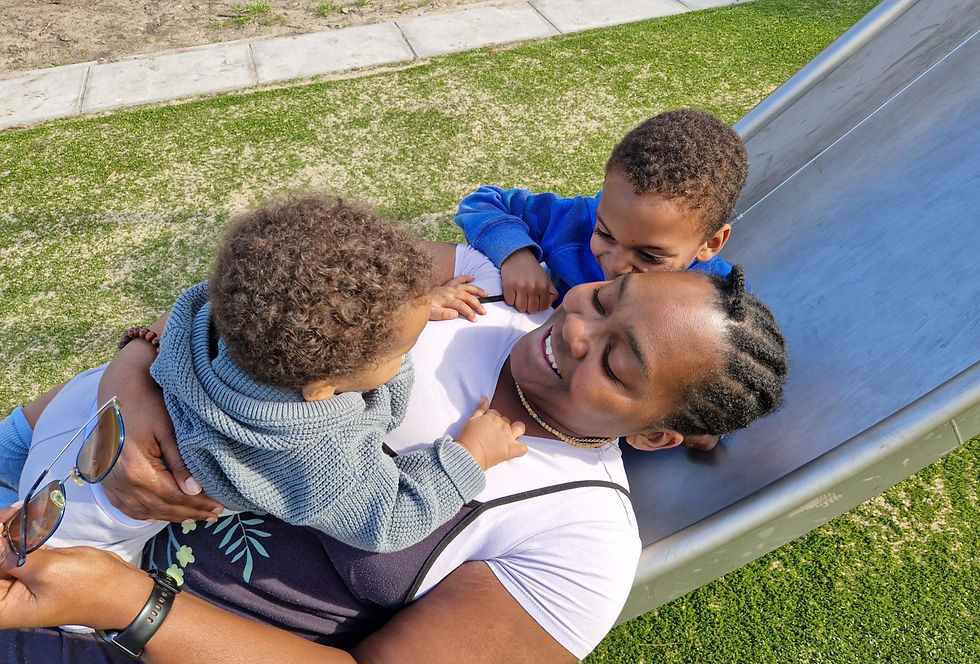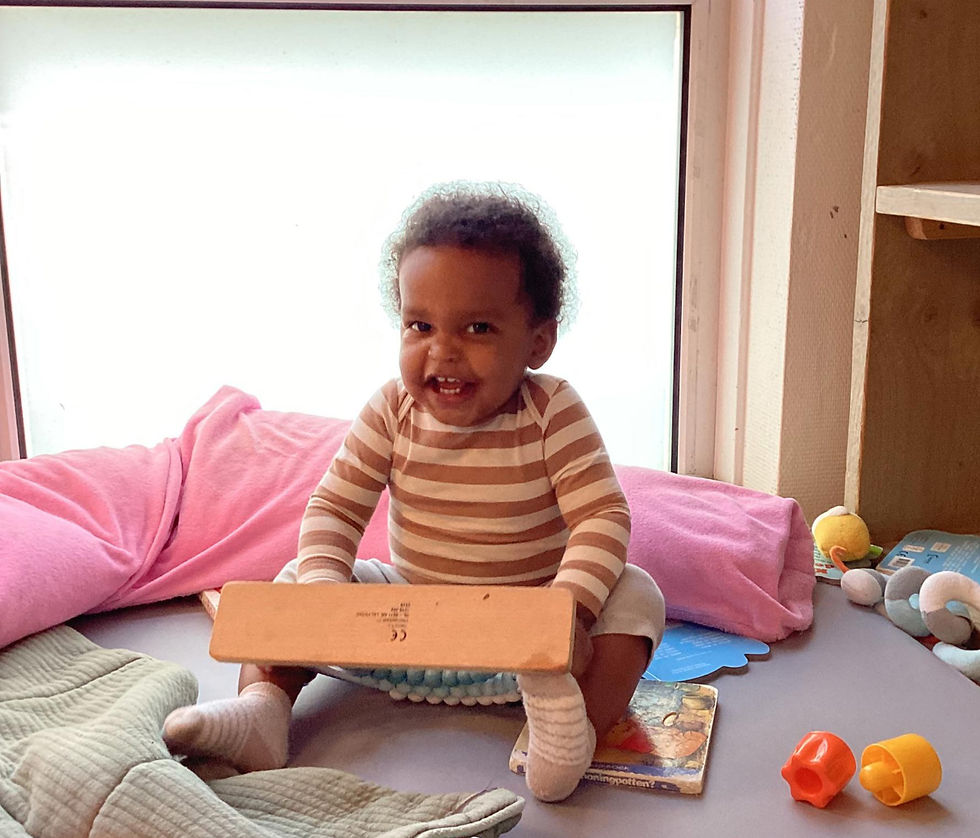Hey hun,
As you may know About me, my family just got a little bigger! It's hard to believe, but it's already been 14 months since our tiny boss, Elijah arrived! The babble is in full swing, and it's music to our ears. He started saying "Dada" and "Mama" at 11 months, and we were over the moon.
This is especially exciting given our oldest son, who is autistic, didn't say his first words until he was three years old. It's been a reminder of how vital communication is in our lives. Interacting with others and each other is one of the most important aspects of social behavior, and it’s something we often take for granted.
Over the years, I’ve become super curious about speech development and have done a ton of research into the first sounds and words babies make and how to encourage them from the start.
Here are some insights and tips from my journey as a mom working on early speech development with both my boys. I hope this helps you too!

What Sounds Do Babies Make First and Why?
As you might have noticed, the language journey begins with the sweetest sounds of coos and gurgles. Your little one is testing out their vocal cords for the very first time. Around two to three months old, these sounds start to evolve slightly. Babies begin experimenting with a variety of noises, producing those delightful coos, gurgles, and sighs.
These early vocalizations are mostly vowels like "ah," "eh," and "oo." There’s a fascinating reason behind these adorable sounds. Both biological and social factors are at play here. Babies' vocal cords and mouth muscles are still in the early stages of development, and vowels are easier for them to produce since they don’t require complex movements of the tongue or lips.
But there's more to it than just physical development. These sounds are a baby’s way of exploring their vocal range and engaging with the world around them, especially with us, their adoring audience. It's their first attempt at communication, and it's incredibly rewarding. You'll notice that the more you respond to their sounds, the more they light up and coo back at you. It's like they're discovering that they have a voice and it can get your attention – a magical realization that often brings out the biggest, most joyful smiles.

What Consonant Sounds Do Babies Typically Make First?
As babies grow, their babbling turns into a more complex and fascinating concert, usually around six to nine months old. This is such an exciting stage because it's when you'll start hearing those precious consonant sounds for the first time.
The first consonants that typically make an appearance are "m," "b," and "d." So, you’ll start hearing adorable sounds like "mama," "baba," and "dada." These particular consonants are easier for babies to produce because they involve simple lip movements.
What makes the "m," "b," and "d" sounds so common is that they can be made with straightforward movements of the lips and tongue, without needing much control over the vocal cords. Babies find these sounds relatively easy to master, and they quickly become a favorite in their growing babble repertoire.
These early consonant sounds are incredibly important. They are the building blocks for later speech development. Think of them as the first steps on a long journey toward full sentences and conversations. Each "mama" and "dada" is a crucial milestone that shows your little one is learning how to use their mouth, lips, and tongue to form words. This is a significant leap from the earlier vowel sounds and coos, indicating that your baby is getting ready to start communicating more clearly and effectively.
Some of the first words they might say:
"Mama" or "Mommy"
"Dada" or "Daddy"
"Baba" (bottle or baby)
"Nana" (banana or grandma)
"Bye-bye"
"Hi"
"Yay"
"Up"
"Yes"
"No"
These words are simple, repetitive, and often associated with things or people the baby loves and sees frequently, making them easier to remember and repeat.
So, when you hear those first "m," "b," and "d" sounds, know that it's not just cute babbling; it's your baby developing the skills they need for future language and speech. And, of course, it's another beautiful opportunity for you to engage, respond, and encourage their budding communication skills.

How You Can Encourage Early Developing Sounds
Encouraging your baby’s speech development can be a fun experience. Here are some fun and effective ways that I used to boost those early sounds in both my kids:
Talk to Your Baby: One of the easiest and most effective ways to encourage your baby’s speech development is simply to talk to them. Narrate your day, describe what you’re doing, and respond to their sounds. This constant exposure to language helps them learn the rhythm and melody of speech. For example, I often place my baby in a high chair next to me in the kitchen. As I’m cooking breakfast, I’ll chat about what I’m doing: “Now, I’m cracking the eggs. Look at how yellow they are! I’m going to whisk them now.” This running commentary might feel a bit silly at first, but it’s incredibly beneficial for your baby. They’re absorbing all those words and sounds, even if they can’t respond yet. Sometimes, I get Christian involved too. He’s great at bringing enthusiasm to these narrations, and Elijah absolutely loves it. Christian might say, “Hey Elijah, I’m pouring the milk into the cereal. Splash! Did you see that?” His excitement is contagious, and it turns an ordinary task into a fun and engaging learning moment for Elijah. By narrating your day and encouraging other family members to do the same, you’re surrounding your baby with rich language input. This constant verbal engagement helps them pick up on the nuances of speech and language, setting a strong foundation for their future communication skills. Plus, it’s a wonderful way to bond and make everyday moments special.
Imitate Sounds: When your baby coos or babbles, mimic those sounds back to them. This not only encourages them to keep vocalizing but also teaches them the basics of conversation. One of the most delightful and effective ways to encourage your baby’s speech development is by mimicking their sounds. When your baby coos or babbles, imitate those sounds back to them. This not only encourages them to keep vocalizing but also teaches them the basics of conversation. Both Christian and Elijah absolutely love it when I sit with them and mimic their sounds. I usually start by repeating simple vowels like "Ah" and "Eh." Then, I add a bit of fun by turning those sounds into a melody. It's amazing to see their little faces light up as they try to imitate the melody. Before you know it, we’re singing together, and those precious moments become a delightful exchange of sounds and smiles.
Play with Sounds: Playing with sounds is another fantastic way to engage your baby. Introduce playful noises during activities to keep things fun and interactive. Use toys that make sounds, sing songs, or play simple word games. The more varied and interesting the sounds, the more engaged your baby will be. Aside from singing to them throughout the day, especially before naps and bedtime, I love using musical or sound books. Elijah has a blast pressing the buttons to hear new sounds. Each button press is a new adventure for him, filled with curiosity and excitement. These playful interactions are not just about making noise; they are about creating rich, sensory experiences that support your baby's language development. By turning everyday moments into opportunities for sound exploration, you’re helping your baby build a strong foundation for their speech and language skills. Plus, it’s a wonderful way to bond and share joyful experiences together.
Read Together: Reading to your baby is one of the most wonderful ways to introduce them to the sounds and patterns of speech. Even if they don't understand the words yet, they’re absorbing the rhythm, tone, and melody of your voice. It’s like giving them a head start in the world of language. To make it more engaging, choose books with repetitive phrases and rhymes. These types of books are not only fun but also easier for babies to follow along with. For example, I’ve incorporated reading into our bedtime routine since the day both Christian and Elijah were born. Every night, we snuggle up with a favorite book and dive into the world of stories. This daily reading ritual is more than just a way to wind down from the day; it’s a fantastic opportunity to introduce new sounds to your baby. The repetition and rhyme help them recognize and predict patterns, which is great for their cognitive development. Plus, it instills a love for books and reading right from the very beginning. By making reading a consistent part of your routine, you’re not only helping your baby’s language development but also creating a special bonding time that both of you will cherish.

Watching and listening as your baby discovers their voice is an incredible journey. It’s amazing to see their personality start to shine through those first sounds and babbles. By understanding the sounds they make first and providing a nurturing environment rich with words and sounds, you can support your little one’s early speech development in the most wonderful ways.
Creating an environment filled with language and interaction is key. Talk to your baby, imitate their sounds, play with noise-making toys, and read together every day. Each of these activities helps your baby learn and grow, making their journey into language a fun and exciting adventure.
Happy babbling!

Commentaires